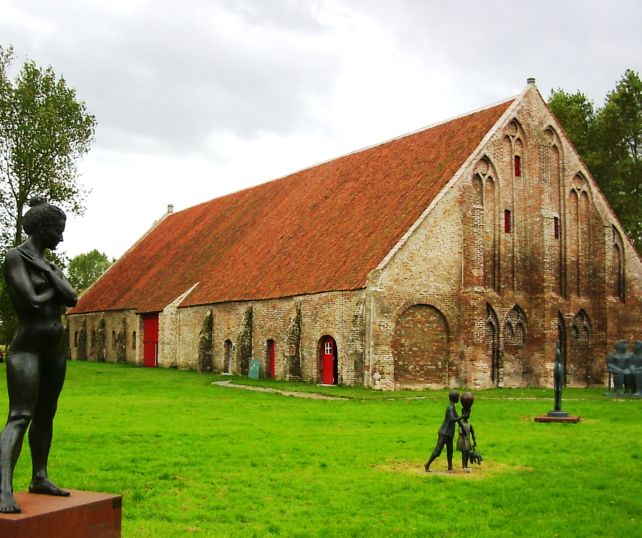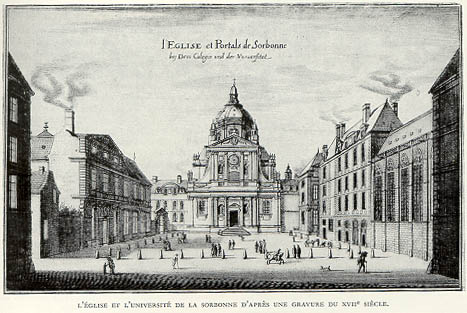|
Jan Van He
Jan van He, Latinized Johannes de Capella (died before April 1311) was a monk of the Cistercian Ter Doest Abbey, in the County of Flanders, who graduated Bachelor of Sacred Theology from the Collège de Sorbonne in the University of Paris in 1303, and taught theology in the college from 1303 to 1306. Adriaan Pattin, "He, Jan van", '' Nationaal Biografisch Woordenboek'', vol. 16 (2002), 426. In 1286 his mother, Margriet, had given him the house she was living in to pay for the books he would need for his studies. In 1311 the use of his books passed to Jan Sindewint Jan Sindewint, Latinized Joannes de Dunis (died 1319) was a monk of the Cistercian Abbey of Dunes in the County of Flanders, and from 1311 a professor of theology at the Collège Saint-Bernard in the University of Paris. In 1311 he acquired the u ..., a monk of the Abbey of Dunes. References Year of birth unknown Year of death unknown College of Sorbonne alumni Academic staff of the University of Paris Cisterci ... [...More Info...] [...Related Items...] OR: [Wikipedia] [Google] [Baidu] |
Cistercian
The Cistercians (), officially the Order of Cistercians (, abbreviated as OCist or SOCist), are a Catholic religious order of monks and nuns that branched off from the Benedictines and follow the Rule of Saint Benedict, as well as the contributions of the highly influential Bernard of Clairvaux, known as the Latin Rule. They are also known as Bernardines, after Bernard of Clairvaux, Saint Bernard, or as White Monks, in reference to the colour of their cowl, as opposed to the black cowl worn by Benedictines. The term ''Cistercian'' derives from ''Cistercium,'' the Latin name for the locale of Cîteaux, near Dijon in eastern France. It was here that a group of Benedictine monks from the monastery of Molesme Abbey, Molesme founded Cîteaux Abbey in 1098. The first three abbots were Robert of Molesme, Alberic of Cîteaux and Stephen Harding. Bernard helped launch a new era when he entered the monastery in the early 1110s with 30 companions. By the end of the 12th century, the ord ... [...More Info...] [...Related Items...] OR: [Wikipedia] [Google] [Baidu] |
Ter Doest Abbey
Ter Doest Abbey () was a Cistercian abbey in Belgium, in the present Lissewege, a district of Bruges, West Flanders. History Lambert, lord of Lissewege, left an estate with a chapel in 1106 to the Benedictines, who built an abbey there. This affiliated itself to the Cistercian order in 1175 as a daughter house of Ten Duinen Abbey in Koksijde, of the filiation of Clairvaux Abbey, Clairvaux. It had a daughter house of its own, the Abbey of Onze Lieve Vrouw Kamer, founded in 1223. The abbey played an important part in the building of dykes and the Polder, reclamation of land in the coastal areas of Flanders, Zeeland and Holland, and also in the wool trade. Saint Thorfinn, otherwise Thorfinn of Hamar, exiled bishop of Hamar in Norway, took refuge at Ter Doest after his opposition to King Eric II of Norway. He died in the abbey on 8 January 1285 and was buried there. Willem van Saeftinghe, a lay brother of Ter Doest, fought with the Flemish in the Battle of the Golden Spurs in 1302 ... [...More Info...] [...Related Items...] OR: [Wikipedia] [Google] [Baidu] |
County Of Flanders
The County of Flanders was one of the most powerful political entities in the medieval Low Countries, located on the North Sea coast of modern-day Belgium and north-eastern France. Unlike the neighbouring states of Duchy of Brabant, Brabant and County of Hainaut, Hainaut, it was within the territory of the France in the Middle Ages, Kingdom of France. The counts of Flanders held the most northerly part of the kingdom, and were among the original twelve Peerage of France#Under the Monarchy: feudal period and Ancien Régime, peers of France. For centuries, the economic activity of the Flemish cities, such as Ghent, Bruges and Ypres, made Flanders one of the most affluent regions in Europe, and also gave them strong international connections to trading partners. Up to 1477, the core area under French suzerainty was west of the Scheldt and historians call this "Royal Flanders" (Dutch: ''Kroon-Vlaanderen'', French: ''Flandre royale''). Aside from this, the counts, from the 11th centu ... [...More Info...] [...Related Items...] OR: [Wikipedia] [Google] [Baidu] |
Bachelor Of Sacred Theology
The Bachelor of Sacred Theology (abbreviated STB) is the first of three ecclesiastical degrees in theology (the second being the Licentiate in Sacred Theology and the third being the Doctorate in Sacred Theology) which are conferred by a number of pontifical faculties around the world. As an ecclesiastical degree, it is conferred in the name of and by the authority of the Holy See. It is often granted alongside a civil degree, such as the Master of Divinity. The curriculum varies slightly from faculty to faculty, but generally requires competency in Latin or Greek as well as the completion of the "first cycle" of theological training, a three to five year course of studies that aims for a comprehensive competence in philosophy and theology. The basic requirements for any of the three ecclesiastical degree are regulated by the Holy See, most recently in the Apostolic Constitution Veritatis Gaudium. References {{reflist "Apostolic Constitution Veritatis Gaudium on Ecclesiastical ... [...More Info...] [...Related Items...] OR: [Wikipedia] [Google] [Baidu] |
Collège De Sorbonne
The College of Sorbonne () was a theological college of the University of Paris, founded in 1253 (confirmed in 1257) by Robert de Sorbon (1201–1274), after whom it was named. The Sorbonne was disestablished by decree of 5 April 1792, after the French Revolution, along with the other Paris colleges. It was restored in 1808, then closed finally in 1882. In recent times the name "Sorbonne" came to refer to the group of liberal arts faculties of the University of Paris, in contrast to the vocational faculties of law and medicine. "Sorbonne" is also used to refer to the main building of the University of Paris in the 5th arrondissement of Paris, which houses several faculties created when the University was divided into thirteen autonomous universities in 1970. Overview Robert de Sorbon was the son of peasants from the village of Sorbon in the Ardennes, who became a master of theology, a canon of the Cathedral of Notre Dame de Paris, and the confessor and chaplain of King ... [...More Info...] [...Related Items...] OR: [Wikipedia] [Google] [Baidu] |
University Of Paris
The University of Paris (), known Metonymy, metonymically as the Sorbonne (), was the leading university in Paris, France, from 1150 to 1970, except for 1793–1806 during the French Revolution. Emerging around 1150 as a corporation associated with the cathedral school of Paris, it was considered the List of medieval universities, second-oldest university in Europe.Charles Homer Haskins: ''The Rise of Universities'', Henry Holt and Company, 1923, p. 292. Officially chartered in 1200 by Philip II of France, King Philip II and recognised in 1215 by Pope Innocent III, it was nicknamed after its theological College of Sorbonne, founded by Robert de Sorbon and chartered by King Louis IX around 1257. Highly reputed internationally for its academic performance in the humanities ever since the Middle Ages – particularly in theology and philosophy – it introduced academic standards and traditions that have endured and spread, such as Doctor (title), doctoral degrees and student nations. ... [...More Info...] [...Related Items...] OR: [Wikipedia] [Google] [Baidu] |
Adriaan Pattin
Adriaan Pattin (1914–2005) was a Belgian historian of medieval philosophy. His 1966 edition of the Pseudo-Aristotelian '' Liber de Causis'', although intended to be "provisional", was for decades the best version available to scholars. Life Pattin was born in Hasselt, Belgium, on 17 June 1914 and joined the Missionary Oblates of Mary Immaculate at the age of 19. He made his vows in 1935 and was ordained to the priesthood in 1941. In 1947 he graduated Licentiate from the Higher Institute of Philosophy in the Catholic University of Leuven. In 1952 he obtained his doctorate with a thesis on being and essence in the philosophy of Thomas Aquinas. He also graduated Master of Arts from the University of Ottawa, where he later returned as a visiting professor. From 1962 until his retirement he was a researcher attached to the De Wulf-Mansion Centre for Ancient and Medieval Philosophy in Leuven. He died in Veurne on 15 August 2005. Works * ''De verhouding tussen zijn en wezenheid en de ... [...More Info...] [...Related Items...] OR: [Wikipedia] [Google] [Baidu] |
Jan Sindewint
Jan Sindewint, Latinized Joannes de Dunis (died 1319) was a monk of the Cistercian Abbey of Dunes in the County of Flanders, and from 1311 a professor of theology at the Collège Saint-Bernard in the University of Paris. In 1311 he acquired the use of the books of the recently deceased Jan van He, a monk of Ter Doest Abbey who had taught theology at the Collège de Sorbonne The College of Sorbonne () was a theological college of the University of Paris, founded in 1253 (confirmed in 1257) by Robert de Sorbon (1201–1274), after whom it was named. The Sorbonne was disestablished by decree of 5 April 1792, after th ... from 1303 to 1306.Adriaan Pattin, "He, Jan van", ''Nationaal Biografisch Woordenboek'', vol. 16 (2002), 426. References Year of birth unknown 1319 deaths University of Paris alumni Academic staff of the University of Paris Cistercians 14th-century Roman Catholic theologians {{theologian-stub ... [...More Info...] [...Related Items...] OR: [Wikipedia] [Google] [Baidu] |
Abbey Of Dunes
Ten Duinen Abbey or the Abbey of the Dunes () was a Cistercian monastery at Koksijde in what is now Belgium. It was one of the richest and most influential religious institutions in the medieval County of Flanders. It later relocated from Koksijde to the city of Bruges. History A religious community was founded in the dunes near Koksijde by the hermit Ligerius in 1107. In 1120 the community took the Rule of St Benedict as its rule of life, and in 1139 it became affiliated to the Cistercian Order. Partly through donations and partly through land reclamation work in the dunes and polders, the monastery developed extensive landholdings on which the lay brothers reared sheep, producing wool for the cloth trade. A dependent house was established at Eastchurch, in Kent, to export wool from England, but was later sold to Boxley Abbey. The daughter house Ter Doest Abbey was founded in 1175 and also became rich and influential. New buildings were begun in 1214 and completed in 1237, to hou ... [...More Info...] [...Related Items...] OR: [Wikipedia] [Google] [Baidu] |
Year Of Birth Unknown
A year is a unit of time based on how long it takes the Earth to orbit the Sun. In scientific use, the tropical year (approximately 365 solar days, 5 hours, 48 minutes, 45 seconds) and the sidereal year (about 20 minutes longer) are more exact. The modern calendar year, as reckoned according to the Gregorian calendar, approximates the tropical year by using a system of leap years. The term 'year' is also used to indicate other periods of roughly similar duration, such as the lunar year (a roughly 354-day cycle of twelve of the Moon's phasessee lunar calendar), as well as periods loosely associated with the calendar or astronomical year, such as the seasonal year, the fiscal year, the academic year, etc. Due to the Earth's axial tilt, the course of a year sees the passing of the seasons, marked by changes in weather, the hours of daylight, and, consequently, vegetation and soil fertility. In temperate and subpolar regions around the planet, four seasons ar ... [...More Info...] [...Related Items...] OR: [Wikipedia] [Google] [Baidu] |






